Debi Mishael
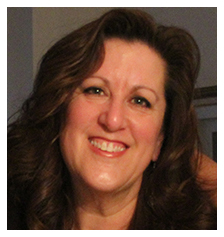 Lana stands nervously in front of the ארון הקודש Aaron HaKodesh. She is in between her grandparents preparing to have pre-Bat Mitzvah pictures taken but I can see something building in her eyes and in her body language.
Lana stands nervously in front of the ארון הקודש Aaron HaKodesh. She is in between her grandparents preparing to have pre-Bat Mitzvah pictures taken but I can see something building in her eyes and in her body language.
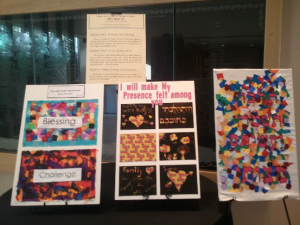 She feels like she is the nut in a vice that is quickly tightening and trapping her in its grip. Her breathing begins to quicken, her hands tighten their wrenching grip on the bottom of her tallit and she begins to get a catatonic stare in her eyes. I interrupt, tell the family photographer it’s time to get some shots of the adorable cousins and led Lana to the quiet and empty back corner of the sanctuary.
She feels like she is the nut in a vice that is quickly tightening and trapping her in its grip. Her breathing begins to quicken, her hands tighten their wrenching grip on the bottom of her tallit and she begins to get a catatonic stare in her eyes. I interrupt, tell the family photographer it’s time to get some shots of the adorable cousins and led Lana to the quiet and empty back corner of the sanctuary.
The immediate crisis is averted and Lana starts to calm but the impending Shabbat service is brought further into question. Will Lana even be able to enter the sanctuary? Will she be overwhelmed by the crowds and the noise? The typical B’nei Mitzvah nerves are compounded exponentially for Lana. Taking family photos to document the simcha seems like one of the easier aspects of typical preparations. For Lana’s family it was just one more hurdle.
One of the four pillars of our congregation is to “meet the spiritual needs of all members-wherever they begin.” I am the family mentor assigned by the congregation to usher the family through the process. What does success look like for Lana? If the congregation and the family can agree that success will look different for Lana, then, it will be recognized when it happens. Art we discover will be the key to success for Lana.
We determine together that there are three goals. First, we make the process of preparing Lana for her Bat Mitzvah the key experience that will bring meaning and transformation. Focusing more on the preparation and deemphasizing “the event” will allow us to control the setting and set ourselves up, as best as possible, for positive outcomes. Second, we ensure that Lana’s studies were content based and not performance based. Finally, create an environment and appropriate expectations that allow Lana to experience a pinnacle moment with the community. If this was possible, she would have a record of success and a president setting example for her to reference when future difficulties arise.
Lana’s parsha is ויקרא Vayikra and it contained rich content to study. Three texts were chosen for her to explore and an art activity was chosen for each. Through the process of completing each art project the details of the texts were fleshed out. Once each project was completed, Lana’s was asked to describe her art and explain her artistic choices. These explanations were recorded on an iPad movie and then transcribed. The transcriptions, with minimal set-up, became Lana’s דבר תורה D’var Torah. Three friends were put on stand-by to read Lana’s comments if she was not able to read them herself. In the end, I am thrilled to report, Lana was in the sanctuary and able to ascent the bima and read her artist’s statements herself. Through a series of accommodations, a supportive clergy and congregation and a process that centered on the student’s needs, Lana had one of the most meaningful simchas I have ever witnessed.
PROJECT ONE: Blessings and Challenge
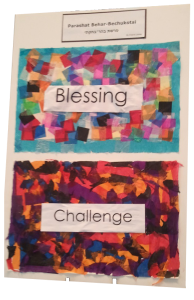 Using no words or visual pictures, Lana was asked to contrast Blessings and Curses using only color and texture. Her Torah portion details the rewards and consequences of observing G-d’s commandments. Lana did not like the word “curse” and looked to her own life experiences for an alternative. She decided “Challenges” was more appropriate.
Using no words or visual pictures, Lana was asked to contrast Blessings and Curses using only color and texture. Her Torah portion details the rewards and consequences of observing G-d’s commandments. Lana did not like the word “curse” and looked to her own life experiences for an alternative. She decided “Challenges” was more appropriate.
“You don’t have to think about it. Just looking at it makes you feel the difference. Blessings are light and Challenges are dark. Even though there are some of the same colors in each, they combine differently. The tissue I used in challenges was ripped in different shapes and sizes. The tissue I used for Blessings has soft cut edges they are clean and you can see them easily. The tissue for Challenges are torn and wrinkled and rough. There is a frame around Blessings. A Blessing is something we want to focus on. I used mod-podge to give Blessings a finished shiny look. I did not make Challenge shiny because it is supposed to be dirty or bumpy and not clean.
If you have something bad and you can’t figure it out, that’s a challenge. If you can figure it out, or recognize it as good, that’s a blessing. Sometimes you can take a challenge and turn it into a blessing by working with it and trying to figure it out. This Torah portion helps us think about consequences or the things that happen because of the actions we take.” From Lana’s Artist Statement
PROJECT TWO: Follow, Guard and Do
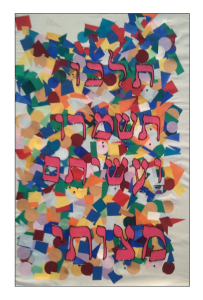 The first line of the portion בחקתי Behukotai uses three different verbs to tell us to observe G-d’s laws. Lana highlighted the three words: you should follow, you should guard and you should do them. She used 613 colored pieces of fabric to represent “them” – the 613 mitzvot.
The first line of the portion בחקתי Behukotai uses three different verbs to tell us to observe G-d’s laws. Lana highlighted the three words: you should follow, you should guard and you should do them. She used 613 colored pieces of fabric to represent “them” – the 613 mitzvot.
“In my second project, we looked at Leviticus 26:3, the first line in Portion בחקתי Behukoti. It tells us to follow, guard and do G-d’s laws. The Rabbis wonder why the Torah uses three verbs to tell us to observe the commandments. Why do we FOLLOW, GUARD or PROTECT and then DO a Mitzvah?
Kids follow grown-ups because they set an example. You have to follow the people you respect. The Torah shows us that it takes time and you have a process to learn what to do. First you try to follow. Then you have to guard them yourself. Then you are really doing it because it has just become the way you do it. All the steps are important.
I think we see this when we walk around with the Torah during services. We follow the Torah around the room and we kiss it to protect it and show we love and honor it. Then we read it and actually do it. We don’t open the ark and just start reading the Torah. We let everyone know we are going to read it. Everyone has to give something to it. If I kiss it, it’s like I am giving something to the Torah. I am guarding it. Everyone needs to keep it protected. We can read it after we follow it and then protect it.”
Excerpt from Lana’s Artist Statement
PROJECT THREE: Finding G-d Around Us
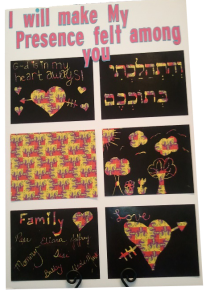 In Vayikra 26:12 we learn that G-d can be felt among us. In this art project, Lana and others illustrate some of the ways we see G-d in our world. Starting with black-out scratch boards, they scratched the black layer off the paper until a colorful image appeared.
In Vayikra 26:12 we learn that G-d can be felt among us. In this art project, Lana and others illustrate some of the ways we see G-d in our world. Starting with black-out scratch boards, they scratched the black layer off the paper until a colorful image appeared.
“Sometimes it is hard to find G-d and we need to look harder. For my final art project, I took dark black scratch off paper and scratched out pictures to show where I see G-d. Sometimes it is dark in our world but we need to scratch away the dark and find the good part things. G-d is always going to be there with us. We need to look.”
Excerpt from Lana’s Artist Statement
OTHER ACCOMODATIONS MADE DURING THE BAT MITZVAH
- Lana sat in the conference room for the first part of the service and did not enter the sanctuary until the Torah service was about to begin.
- Lana stayed up on the bima during the Torah procession around the congregation. She needed to be insulated from the large crowds of congregants.
- Lana’s friends help the art posters while Lana read her artist’s statements. The friends were prepared to read the statements if it became necessary.

